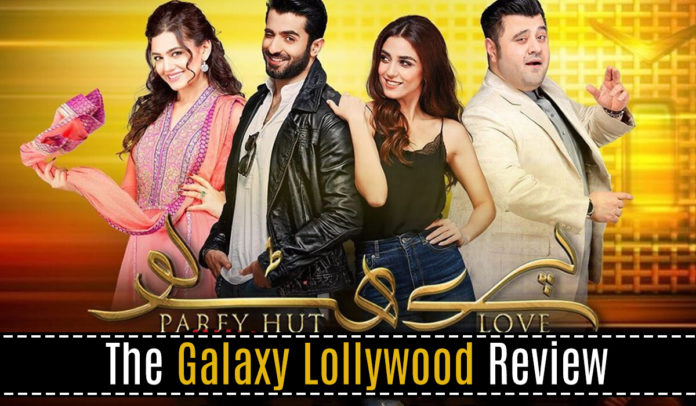Film: Parey Hut Love
Release Date: 12th August, 2019
Directed By: Asim Raza
Review By: Hassan Hassan
“Kamyaabi ka ussol hai logon ko maza karao, jeena mat sikhao.” Fawad Khan says in his brief cameo in Parey Hut Love. When I was leaving the cinema after the film’s end credit song, it was this line from the film itself that came to my mind because it succinctly summarized the entire Parey Hut Love experience for me.
The escapist rom-com that I had witnessed seemed palatable after applying this dialogue to the film’s context as I came to understand the motives of the makers, which were simply to entertain the viewers with gloss and glamour, and avoid any moment that would move the film towards any preachy territory. Which then translates on the big screen as a grand cinematic experience full of color, zing, a heavy dose of beauty and aesthetically pleasing shots, soulful music, but all of it sans a noticeable story.
And that is where the Achilles’s heel of PHL resides, all exposed and ready to be struck at, that brings the film down from the glamorous grand scale that it has perched itself on – the lack of a proper story line.
What Parey Hut Love is about
PHL is a piece of complex artsy cinema that draws elements from a host of cinematic eras/genres encompassing the golden age Pakistani cinema as well as the Yash Raj/Dharma brand of Bollywood to name a few. The template of the film as well as some incidents in it are based loosely on the classic British rom-com Four Weddings and a Funeral, and the makers of the film have readily owned up to this fact.
The film follows a handsome, commitment-phobic, struggling actor Sheheryar (Sheheryar Munawar) who falls in love with Saniya (Maya Ali), who is following her post-graduation in Turkey and is daughter to one of the most prolific writer of the golden age of Pakistani cinema, Faisal (Nadeem Baig). Their romance blossoms at a family wedding and later has to witness a rather tumultuous journey at the backdrop of three more weddings. In between, the two central characters of the film have to take critical decisions regarding their individual lives as well as the fate of their relationship in a limited time that life provides them.
How the young couple realize their love for each other and what they do with that realization is what you’re going to witness on big screen.
The strong acting performances
Among the many strengths of the film, the most obvious one remains to be the lead couple and they way they have delivered their performances.
Parey Hut Love remains Sheheryar Munawar’s show for most of the time and he carries the film quite effortlessly on his shoulders. His is the most well written and complex character of the film. As a budding actor with a rebel inside who displays his anger in rather juvenile ways on and off, Munawar has probably delivered the best performance to his career till date. He yearns for a respectable social stature, but isn’t ready to open himself to further challenging avenues, fearing a dilution of his attention. Despite being an intelligent man, the way he handles difficult situations ends up affecting his equation with his peers and love interest, often landing him and people closest to him in trouble. Munawar makes the audience connect with Sheheryar’s frustration and helplessness, so when the big breakdown moments happen for the character, the audience is fully invested in Sheheryar’s fate. Not only does Sheheryar Munawar look good on the big screen, he proves his mettle as an actor by delivering a very memorable performance.
Maya Ali is another feather in the cap of PHL. Although Saniya appears and disappears rather jarringly in the film, but Ali owns whatever frames she is featured in. From a feisty and intelligent girl who does not shy away from engaging in flirtatious banters, to a loving daughter readily obedient to all her father’s wishes, and then a heartbroken woman hurt by the love she holds in her heart for a man, she brings all shades of Saniya alive by using her facial muscles and body language. Maya Ali is growing project by project as an actor and there is no second opinion on how beautiful she looks on screen.
Among the long list of the supporting cast, it is the veteran actor Nadeem Baig who impresses the most. Baig’s character has perhaps the most long lasting effect on the film’s narrative as the lead characters’ motives are largely influenced by his presence. Faisal hails from the long lost era of the golden age of Pakistani cinema, and his yearning to rekindle his once illustrious writing career provides much depth to the otherwise shallow story line of the fuilm. The sequence where Baig narrates the well know poem “Hamesha Der Kar Deta Hoon” by Munir Niyazi in a voiceover, as a tired Faisal walks towards his writing desk, is one the strongest moments of the film, both visually and emotionally moving, and is worthy of applause.
Zara Noor Abbas sparkles on the big screen, despite the fact that her character Shabbo is not given any depth and is present in the narrative mostly for comic relief. As Shabbo, who is a small town girl and an aspiring actor, Zara looks part and has impeccable comic timings. She has succeeded in making sure Shabbo does not come across as caricaturish and plays the rather naive character with genuine earnestness and innocence.
Ahmed Ali Butt does what Ahmed Ali Butt does best. His character, Arshad, is Sheheryar’s best friend and he aspires to become a successful director. Butt’s comic timing is as always on point but unfortunately, not all of his jokes land. The humor he provides is a mix of witty quips and exaggerated body gestures and while the former brought laughter at many expected and unexpected places, the latter felt very unnecessary. Like Zara, Ahmed Ali Butt also does not get a more carefully written character. However, the two actors share a wonderful chemistry onscreen and the back and forth between Shabbo and Arshad was a delight to witness.
Hina Dilpazeer, who plays Sheheryar’s mother, is another victim of confused characterization. Her motives and ambitions aren’t explained properly. She is shown as a rich lady who is happily married to a rich businessman after her marriage with Sheheryar’s father ended. At no point anything else about her character is explained and then she ends up taking a decision which seemed to be present in the narrative solely to forcibly bring a conflict in Sheheryar’s life. The fault lies in the way the character is written and Dilpazeer does not entirely succeed in rising above the weak writing despite being her usual hilariously charming self onscreen.
Rest of the supporting cast appear for few or more scenes and while they do look beautiful onscreen, there is not much to write home about. An extended cameo by Mahira Khan near the end adds freshness to the story but her appearance and disappearance seems so forced that it leaves a lot to be desired.
Top notch production value and chart-busting music
The music of the film is already a chart buster and is covered extensively by media for its quality and diversity. From a qawali to a romantic ballad to dance numbers, the music director Azaan Sami Khan has composed something for everyone. It is arguably the best music album of the year so far. Also, the way the songs are picturized is something never seen before in the resurgent Pakistani cinema. The songs come in the right places in the film and they take the narrative of the film further instead of being treated as a filler.
The production values of the film can be regarded a landmark with respect to the emergent Pakistani cinema as it is definitely the most gorgeous looking film to come out in the recent years. Salman Razzaq and Serkan Guller’s cinematography where they used anamorphic lenses adds depth to frames and there is not a single moment where the footage looks “non filmy”. From art direction to production design, everything in PHL appears lush and oozes grandeur. The cinematographic choices taken in few key scenes of the film elevate the emotions and makes sure the audience’s focus remains glued to the screen.
No making up for a weak story
Unfortunately, such is the grandeur of the palette of this film that it overpowers the film’s narrative and at many moments viewers may feel as if they are seeing a collage of beautifully shot videos with filler scenes interspersed, instead of a film bound together by a cohesive story line. However, the concentration on grandeur could be seen conversely too. While many viewers may love the rich colors, bright lights, and beautiful people dancing around in grand, beautifully decorated locations while dressed faultlessly in ornate wardrobes, a considerable chunk of people are bound to complain about the absence of a meatier story and ample plot twists that a viewer desires in a film.
By the mid of the second half you may start to question the predilection of the makers towards gloss and glamour as rather unnecessary. What is covered over four weddings could be easily narrated in a lesser number of nuptial events, hence preventing the monotony in the screenplay that moves at a snail’s speed, especially in the second half. Despite the film’s dialogues being adequate to impressive, the fatal flaw of the film, that is its very weak story line, is just impossible to ignore.
The scenes and sequences when seen individually are not short of an artwork, but when viewed together there hardly is any palpable story, especially since it is narrated in a linear manner. The various time jumps in the film, owing to the film’s narrative style, does not help in establishing a coherent story. Because the film focuses on some key “moments” in the characters’ life and not on the journey that leads to those moments, the audience is stripped off of the necessary build up that is important for the payoff of those scenes to be worth it.
However, to the director Asim Raza’s credit, he does manage to deliver the emotion of those key moments perfectly. The romance of the film is treated like magic, the confrontations are engrossing, the breakdown scenes are dramatic and manage to make grief look both beautiful and raw. So, all is not lost in this glossy fairy tale.
Verdict
Whereas the grand visual appeal, peppy music, and brilliant performances do not completely make up for the lack of a proper story line, Parey Hut Love could still very well emerge as popular choice for the youth thanks to the positives.
Rating: 3/5 stars




